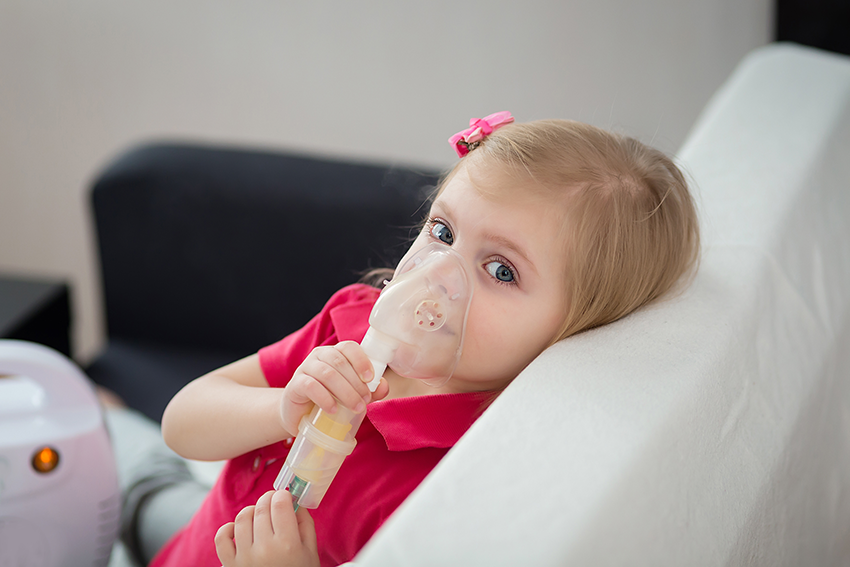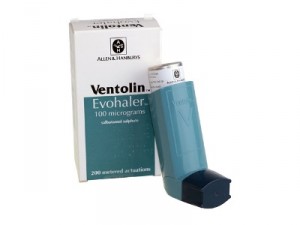Due to the deterioration of the environment and a significant increase in respiratory infections, children’s immunity is greatly reduced. That is why we meet infant asthma and various allergies more often nowadays. Canadian HealthCare Mall will ennumerate all the necessary items you should know about asthma.
 Asthma is a chronic disease caused by airway inflammation and, consequently, a spasm of the bronchial tubes, which begin to secrete large amounts of mucus. This prevents the normal passage of air going through the respiratory tract. Bronchial asthma is classified into two types:
Asthma is a chronic disease caused by airway inflammation and, consequently, a spasm of the bronchial tubes, which begin to secrete large amounts of mucus. This prevents the normal passage of air going through the respiratory tract. Bronchial asthma is classified into two types:
The first type of asthma can be caused by exposure to allergen particles: dust, pollen, certain foods, cat or dog hair, perfume and so on. In case of children, 90% of the diseases are atopic. Non-atopic cases are quite rare and occur only in case when a child’s organism has excessive sensitivity to infectious allergens.
Bronchial asthma has three forms of the disease severity:
Depending on the severity of attacks, it is necessary to use some means aimed at arresting them. In most cases, children suffering from diseases such as bronchial asthma have predisposition to this illness since birth – in their genes. Out of 100 asthmatics at least 60 of them have relatives suffering from the same disease. In addition to heredity, bad environment affects the child’s genes very badly.
 It’s difficult to diagnose children with asthma at once. This happens due to the fact that quite often the disease has the same symptoms as the common cold and viral respiratory diseases. Often parents do not realize that some of the symptoms indicate a much more serious disease than the common cold.
It’s difficult to diagnose children with asthma at once. This happens due to the fact that quite often the disease has the same symptoms as the common cold and viral respiratory diseases. Often parents do not realize that some of the symptoms indicate a much more serious disease than the common cold.
However, at asthma ichildren do not have fever, even if the cough is very frequent and dry. Before the asthma symptoms there usually occur precursors a few days before. Their duration is different for each child. During this time, children are often angry, scared, are in constant agitation, they sleep poorly.
Forerunners proceed in the following way:
Children older than one year (in addition to the above features) are also having following symptoms:
 The most important reason for the asthma attacks is bronchial hyperreactivity of children, they react to various irritants too quickly, especially of allergenic nature.
The most important reason for the asthma attacks is bronchial hyperreactivity of children, they react to various irritants too quickly, especially of allergenic nature.
All the reasons for developing the disease, are divided into several groups.
According to internal factors at the genetic level and health:
Gender. Among children with asthma boys get sick more often. This happens due to the structural features of bronchial and respiratory system;
Excess weight or obeseity. These children have asthma more often because of the high position of the diaphragm, lung ventilation in this arrangement is insufficient for normal and free breathing. Therefore, children with overweight often suffer from shortness of breath and asthma;
Heredity. If someone from the family suffers from asthma attacks or allergies, the risk of manifestation of the disease in a child increases significantly.
The impact of external factors:
Triggers – the reasons of bronchospasm occurance:
 Parents must timely recognize the attack of asthma in their child and to stop it as quickly as possible. They should take the following important steps to make things right:
Parents must timely recognize the attack of asthma in their child and to stop it as quickly as possible. They should take the following important steps to make things right:
Listen to your child:
Analyze the child’s breathing:
Evaluate the appearance of the baby:
Help your child:
 Chronic asthma is currently can not be cured. Despite the constant development of medicine there is no such medicine. There are only drugs that can stop an attack, destroy the allergen in the body. Moreover, drugs are prescribed in several stages, with a gradual increase in the dosage of the active substance. Number of received drug depends on the severity of asthma attacks.
Chronic asthma is currently can not be cured. Despite the constant development of medicine there is no such medicine. There are only drugs that can stop an attack, destroy the allergen in the body. Moreover, drugs are prescribed in several stages, with a gradual increase in the dosage of the active substance. Number of received drug depends on the severity of asthma attacks.
Any treatment should take place under the strict supervision of the attending physician. He decides to decrease or increase the dosage of drugs.
Current drugs for the treatment of this disease are divided into several groups:
 The first group is designed to relieve the spasm of the bronchi and the free passage of air through the airways (bronchodilators). They include tools that are taken in case of emergency during an asthmatic attack, to enable a person to breathe normally. these drugs are used only when needed, but not as prophylaxis.
The first group is designed to relieve the spasm of the bronchi and the free passage of air through the airways (bronchodilators). They include tools that are taken in case of emergency during an asthmatic attack, to enable a person to breathe normally. these drugs are used only when needed, but not as prophylaxis.
The second group of drugs designed to relieve inflammation, removing the allergen from the body (Cromones, anticholinergic drugs and antileukotriene, glucocorticoid hormones). These drugs are intended for continuous treatment or prevention of asthma attacks. Unlike the first group, they do not have an instant effect on the removal of spasm of the bronchi and relieve choking. Basic preparations are aimed at minimizing inflammation in the bronchi, its suppression, as well as to reduce the number of asthma attacks or completely stop them.
Anti-inflammatory drugs are usually taken quite a long time. The result of receiving basic drugs appears not once, but only after 2-3 weeks of continuous treatment.
Glucocorticoid hormones have many undesirable side effects (no matter in what form they are taken (tablets or injections):
However, modern technologies make it possible to create more and more new drugs that are effective against the disease, and the side effects from them are minimal, almost reduced to zero. Inhaled glucocorticoids today are the best local preparations. This is a fairly large group of drugs, which are made of synthetic materials and are available in the form of an inhaler or nebulizer.
In the treatment of asthma, inhaled glucocorticoids have helped to make a really good step forward. They are well tolerated by almost all children, do not have a large list of side effects, do not cause allergic reactions. They can be used not only by children but also by adults.
In addition, there are sprays and other treatments for asthma:
People also organize specialized schools for children suffering from asthma attacks, which chiildren must attend during treatment. In these schools the child will learn about measures of prevention of attacks, about the correct breathing techniques, learn about preparations that are necessary for the treatment, as well as choose the right and most effective treatment and diet.
 You need also preventive maintenance to make asthma attacks rare (in addition to direct treatment). We speak of immunity hardening and the general child’s condition omproving. Prevention is a mandatory measure in cases where a child has a predisposition to asthma at the gene level. What should be done for the prevention of disease:
You need also preventive maintenance to make asthma attacks rare (in addition to direct treatment). We speak of immunity hardening and the general child’s condition omproving. Prevention is a mandatory measure in cases where a child has a predisposition to asthma at the gene level. What should be done for the prevention of disease:
Breastfeeding of babies from the first days of life and a till minimum 1 year. If a mother can not carry out breastfeeding or she is forced to stop, the feeding mixture must be chosen carefully, in consultation with the pediatrician;
In addition, it is very important to have a warm and congenial atmosphere in the home. Children should feel care and support from their parents. On this condition asthma attacks will not be so frequent.
Category: Asthma
Tags: asthma attacks, Asthma treatment, children